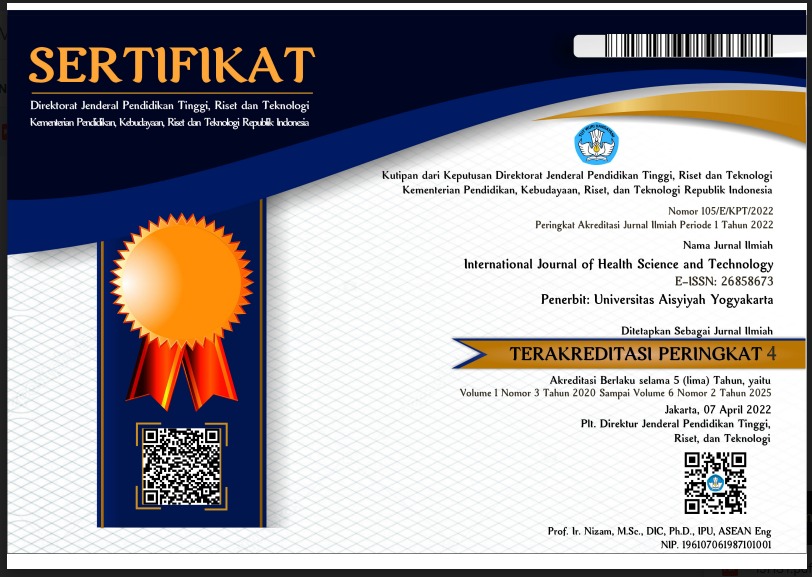The effect of nei-guan point acupressur massage on emesis gravidarum
DOI:
https://doi.org/10.31101/ijhst.v3i3.2359Abstract views 517 times
Keywords:
nei-guan, emesis gravidarum, pregnant, first trimesterAbstract
References
American Pregnancy Association. (2021). American Pregnancy Association - Promoting Pregnancy Wellness. Published online 2018. http://americanpregnancy.org/pregnancyhealth/smoking.html%5Cnzotero://attachment/10/
Arviana, A. (2017). Hubungan Morbiditas Pre Menstrual Syndrom (PMS) dengan Tingkat Kecemasan dan Kualitas Tidur pada Remaja Putri (Doctoral Dissertation, Universuty of Muhammadiyah Malang).
Badan Pusat Statistik, Badan Koordinasi Keluarga Berencanan Nasional, Departemen Kesehatan, Macro International. Survei Demografi dan Kesehatan Indonesia 2012. Sdki. Published online 2013:16. doi:10.1111/j.1471-0528.2007.01580.x
Dibble, S., Luce, I., Cooper, B. A., & Israel, J. (2007). Accupressure for chemotherapy induced nausea and vomiting a randimized clinical trial. Oncology Nursing Forum, 34(4).
Elnashar, A. T., Ali, E. M., & Gaber, A. (2011). The prognostic value of triple negative in stage II / III breast cancer. Journal of Pharmacy Practice, 18(1), 68–75. https://doi.org/10.1177/1078155211398299
Elsa, Viki. Pertiwi, Widyaning H. (2019). Hubungan Paritas Ibu Hamil Trimester I Dengan Kejadian Emesis Gravidarum Di Puskesmas Teras. J Kebidanan. 2012;IV(02):35-48.
Fengge, A. (2012). Terapi akupresur manfaat & teknik pengobatan. Yogyakarta: Crop Cirlce Corp.
Grove, S. K., Gray, J. R., & Burns, N. (2015). Understanding Nursing Research : Building an Evidence -Based Practice. St. Louis Missouri: Saunders Elsevier.
Herrel, Ernest Howard. 2013. Nausea and Vomiting of Pregnancy. American Family Physician 89 (12) :965-970.
Jannah, (2019). Konsep Dokumentasi Kebidanan. Yogyakarta: Ar-Ruzz Medika.
Kim, T. H., Choi, B. M., Chin, J. H., Lee, M. S., Kim, D. H., & Noh, G. J. (2007).The reliability and validity of the rhodes index of Nausea , vomiting and renching in postoperative nausea and vomiting, 52(6), 59–65.
Kadir, Irna & Saleha, Sitti & Nadyah, Nadyah. (2019). Manajemen Asuhan Kebidanan Antenatal Care pada Ny “N†dengan Hiperemesis Gravidarum Tingkat III di Rsud Syekh Yusuf Gowa Tanggal 3 Juni-12 Juli 2019. Jurnal Midwifery. 1. 10.24252/jmw.v1i2.10832.
Kasumayanti, E. (2017). Faktor-Faktor Yang Berhubungan Dengan Infeksi Nosokomial Pada Pengelola Limbah Medis Padat (Cleaning Service) Di Rsud Bangkinang Tahun 2016. Jurnal Ners, 1(2). Https://Doi.Org/10.31004/Jn.V1i2.11
Lowdermilk. Perry. Cashion.Alden. 2012. Maternity and Womens Health Care.Elsevier.
Mariza, Ana. Ayuningtias, Lia. (2019). Penerapan akupresur pada titik P6 terhadap emesis gravidarum pada ibu hamil trimester 1. Holistik J Kesehat. 2019;13(3):218-224. doi:10.33024/hjk.v13i3.1363
Miftahul, Jannah. (2019). Hubungan usia, paritas, dan jarak kehamilan dengan lama rawatan pada pasien hiperemesis gravidarum di RSIA Siti Hawa Padang. http://scholar.unand.ac.id/46594/
Notoatmojo, S. (2018). Metodologi Penelitian Kesehatan. Cetakan Ketiga. Jakarta: PT. Rineka Cipta.
Rahma M, Safura TR. (2016). Asuhan Pada Ibu Hamil Trimester I Dengan Hiperemesis Gravidarum Tingkat I Care of Pregnant Women With Hyperemesis Gravidarum Trimester I Level I. Midwife J. 2016;2(02):50-58. http://jurnal.ibijabar.org/asuhan-pada-ibu-hamil-trimester-i-dengan-hiperemesis-gravidarum-tingkat-i/
Rahayu A, Yulidasari F, Octaviana A, Anggaini L. (2018). Stunting Dan Upaya Pencegahannya. Yogyakarta: CV. Mine.
Royal College of Obstetricians & Gynaecologists. 2016. The Management of Nausea and Vomiting of Pregnancy and Hyperemesis Gravidarum. RCOG Green Top Guideline(69).
Salindri, A. (2018). Anemia. Univ Pas. Published online 2018:11-29. http://repository.unpas.ac.id/37105/1/BAB II.pdf
Somoyani, Ni Ketut. (2018). Literature Review: Terapi Komplementer Untuk Mengurangi Mual Muntah Pada Masa Kehamilan. J Ilm Kebidanan. 2018;8(1):10-17. http://www.ejournal.poltekkes-denpasar.ac.id/index.php/JIK/article/view/1193/405
Sugiyono. (2016). Metode Penelitian Kuantitatif, Kualitatif, dan R&D. Bandung: Alfabeta.
Sumardi. (2016). Gambaran Dukungan Keluarga Terhadap Ibu Hamil Dengan Hiperemesis Gravidarum. http://repository.umy.ac.id/bitstream/handle/123456789/2776/naskah%20publikasi.pdf?sequence=11&isAllowed=y
Wiknjosastro H. (2009). Ilmu Kebidanan. Edisi ke-4 Cetakan ke-2. Jakarta: Yayasan Bina Pustaka Sarwono Prawirohardjo.
Downloads
Published
How to Cite
Issue
Section
License
International Journal of Health Science and Technology allows readers to read, download, copy, distribute, print, search, or link to its articles' full texts and allows readers to use them for any other lawful purpose. The journal allows the author(s) to hold the copyright without restrictions. Finally, the journal allows the author(s) to retain publishing rights without restrictions
- Authors are allowed to archive their submitted article in an open access repository
- Authors are allowed to archive the final published article in an open access repository with an acknowledgment of its initial publication in this journal

This work is licensed under a Creative Commons Attribution-ShareAlike 4.0 Generic License.










